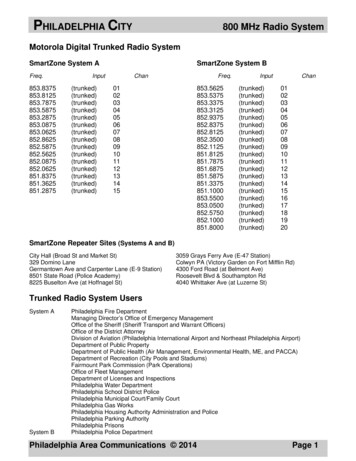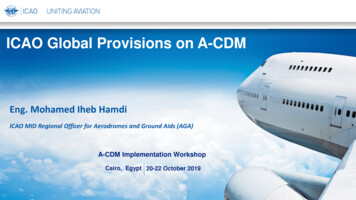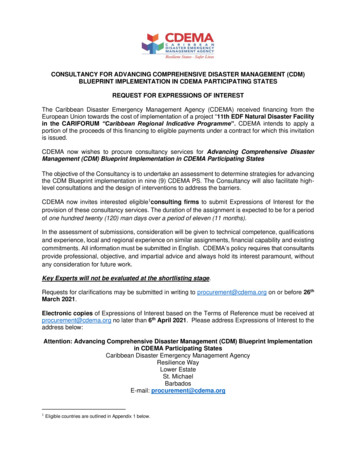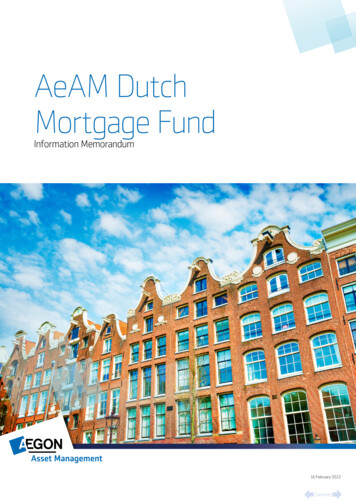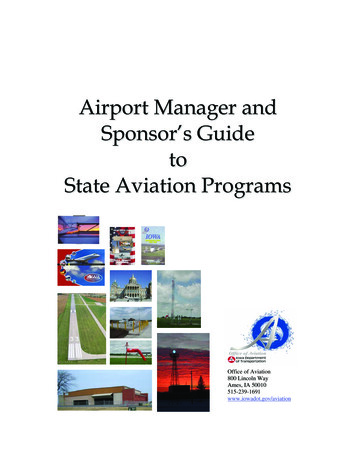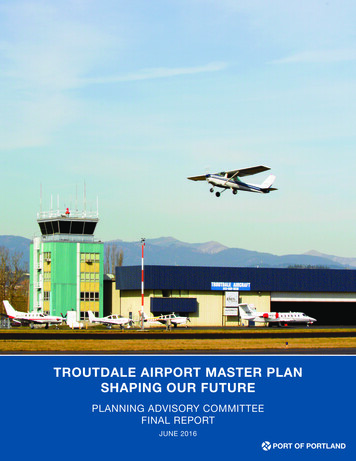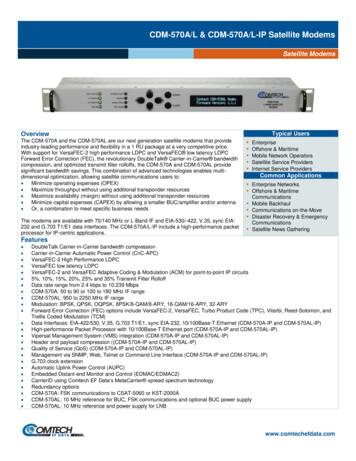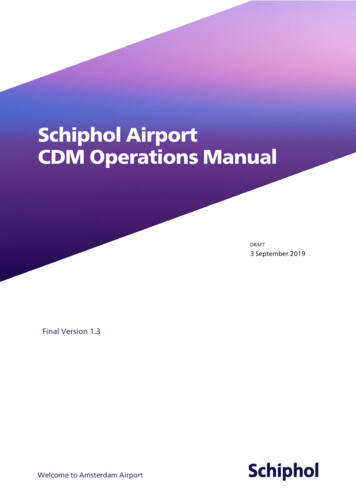
Transcription
Schiphol AirportCDM Operations ManualDRAFT3 September 2019Final Version 1.3Welcome to Amsterdam Airport
Schiphol AirportCDM Operations ManualTable of contentsDocument Control41Introduction1.1The Airport CDM Concept1.2CDM at Schiphol Airport1.3Purpose of the Document1.4Reference Documents1.5Contact6666672Standardized Processes – The Overview2.1Information Sharing2.2The Milestone Approach (Turnaround Process)2.3Variable Taxi Times2.4Pre-departure Sequence2.5A-CDM During Winter Operations2.6A-CDM in Adverse Conditions2.7Collaborative Management of Flight Updates2.8Connection to NMOC8991213131314143CDM@AMS Procedures3.1Estimated Landing Time (ELDT)3.2Estimated In-Block Time (EIBT)3.3A-CDM Flightstates3.4Actual Landing Time (ALDT)3.5Actual In-Block Time (AIBT)3.6Minimum Turnaround Time (MTT)3.7Target Off-Block Time (TOBT)3.8Target Start-up Approval Time (TSAT) & Target Take-Off Time (TTOT)3.9Actual Start-up Request Time (ASRT)3.10 Departure Aircraft is Blocking Stand for Inbound Aircraft3.11 Start-up Procedure3.12 Actual Off-Block Time (AOBT)3.13 Actual Take-Off Time (ATOT)3.14 De-icing3.15 CDM Alerts3.16 Flight Plan (EOBT) ency and Fallback ry of Key Responsibilities5.1Airline Operator5.2Main Ground Handler5.3De-icing Coordinator5.4Pilot5.5ATC383838383939Page 2 of 73
Schiphol AirportCDM Operations Manual5.63.Airport OperatorCDM Portal3940Abbreviations41AppendicesApendix 1: CDM Procedure 1.3 – ELDTApendix 2: Procedure 2.3 – EIBTApendix 3: Procedure 3A.3 – Inbound FlightstatesApendix 4: Procedure 3B.2 – Turnaround FlightstatesApendix 5: Procedure 3C.2 – Outbound FlightstatesApendix 6: Procedure 4C.1 – Non-In-Block AlertApendix 7: Procedure 4E.1 – Holding AlertApendix 8: Procedure 4G.2 – Boarding AlertApendix 9: Procedure 4J.1 – Flight not compliant with TOBT/TSAT AlertApendix 10: Procedure 4K.1 – EOBT/TOBT discrepancy AlertApendix 11: Procedure 5.1 – ALDTApendix 12: Procedure 6.1 – AIBTApendix 13: Procedure 7.5 – TOBTApendix 14: Procedure 8.2 – MTTApendix 15: Procedure 10.5 – TSAT/TTOTApendix 16: Procedure 11.5 – Start-Up procedureApendix 17: Procedure 12.3 – De-icing procedureApendix 18: Procedure 13.2 – AOBTApendix 19: Procedure 14.1 – ATOTApendix 20: Procedure 15.5 – ASRTApendix 21: A-CDM Rules & 7071Page 3 of 73
Schiphol AirportCDM Operations ManualDocument ControlTable 1: Change RecordVersionDateAuthor(s)Change reference0.10.26-feb-20128-mar-2013Initial draft versionDraft 3-may-2013F. Duivenvoorde (AAS)A. Jongen (LVNL)F. Olislagers (LVNL)F. Duivenvoorde (AAS)A. Jongen (LVNL)A. Jongen (LVNL) F.Olislagers (LVNL),F. Duivenvoorde (AAS)A. Jongen, (LVNL) F.Duivenvoorde (AAS)A. Jongen (LVNL), F.Olislagers (LVNL),F. Duivenvoorde (AAS)0.9214-may2013F. Duivenvoorde (AAS)0.935-nov-2013F. Duivenvoorde (AAS)0.9421 mei2014F. Sonsma (KLM)0.95B.D. Onnes (AAS)H. Kelder (KLM)Added A-CDM de-icing information0.970.980.990.99.115 Oct201412 Dec201401 okt 201503 okt 201518 okt 201523 okt 2015Updated chapters 3, 4 and 6Last draft version for approval byCDM@AMS Program for publication anduse under CDM@AMS - Local OperationsApproved draft version by A-CDMImplementation Board for publicationon www.schiphol.nl/cdmA-CDM Implementation Board decision:Note in paragraph “3.10.1 Scenarios”regarding REA message removedUpdate due to temporarily departureprocess fully ready to enable A-CDMLocal OperationsFeedback put throughJ. van Buuren (AAS)H. Kelder (KLM)E. Derogee (AAS)E. Derogee (AAS)1.01.128 okt 20151 dec 2015E. Derogee (AAS)E. Derogee (AAS)Update 3.09 and 3.11Update de-icing informationChapter 10 has been removedSeveral updates (FDU en DZ) ; CDM- ACDMFinal VersionCommunication scheme fallbackupdated0.96Updated chapters 3 and 5 after reviewUpdated other chapters after reviewUpdated after review by Advisory Group.Page 4 of 73
Schiphol AirportCDM Operations Manual1.216 mei20181.33September2019Y. Alexopoulos (AAS),D. Zwaaf (LVNL), F.Sonsma (KLM).Y. Alexopoulos (AAS),E. van Leeuwen (AAS),D. Zwaaf (LVNL), H.Kelder (KLM)Updated doc. in general and addedchapter 5New layout, general updates &CDM@AMS procedures added.Table 2: Review and ApprovalNamePositionYiannis AlexopoulosAAS CDM Business ExpertEric van LeeuwenAAS CDM Business ExpertDavid ZwaafLVNL CDM Business ExpertHans KelderKLM CDM Business ExpertPage 5 of 73
Schiphol AirportCDM Operations Manual1 Introduction1.1 The Airport CDM ConceptThe Airport CDM (Collaborative Decision Making) concept is defined in a wide scale ofdocumentation provided by EUROCONTROL. Although the concept includes a wide variety ofdifferent standards and constraints, the implementation of the concept is always a localprocess.1.2 CDM at Schiphol AirportCDM at Schiphol Airport (also referred as CDM@AMS) is a joint initiative between theairlines, handlers, LVNL and Amsterdam Airport Schiphol. The key aims are to facilitate thesharing of operational processes and data to allow better informed decisions to be made.Implementation at other major European Airports has shown improvements in stand andgate management, resource management, slot adherence leading to reduced costs for allparties and improved accuracy of passenger information.CDM at Schiphol is supported by Eurocontrol and activities, where possible, will be carriedout in line with the Eurocontrol Airport CDM concept elements as described in theEurocontrol Airport CDM Implementation Manual.The aim of CDM at Schiphol is to optimize the turnaround process in order to assure the bestpossible coordination of resources. Providing A-CDM business process stakeholders withaccurate and timely information so that decisions can be made to ensure that theturnaround of a flight is efficient and everyone has a common awareness of the situation.Partners will also be alerted to potential delays and discrepancies by alerts in the system andprompted to take corrective action to ensure a correct flow of data and information.1.3 Purpose of the DocumentThis document is intended to: Describe the CDM at Schiphol operational and local departure planning proceduresand clearly define associated responsibilities Support the CDM process at Amsterdam Airport Schiphol.1.4 Reference DocumentsThe following documents are referred to:1. EUROCONTROL Airport CDM Implementation Manual V5.0 (March 2017)2. Effective CDM@AMS Operational Procedures (available in appendices of thisdocument)Page 6 of 73
Schiphol AirportCDM Operations Manual1.5 ContactIf you have any operational, flight-related questions, experience a technical problemconcerning A-CDM operational flight information or have a general question about CDM atSchiphol, please contact the A-CDM Contact desk.This service is provided 24/7 by AAS, Apron Planning & Control:Phone: 31 (0)20 601 8100 (24/7)Email: CDM@schiphol.nl (office hours)For A-CDM related questions please check answers on the FAQ’s on the Schiphol A-CDMWebsite (www.schiphol.nl/cdm) first.If you have any technical problem concerning A-CDM operational flight information pleasecontact the A-CDM Contact desk. They will provide you with further assistance if needed andin case of severe technical problems they will contact the FMA to initiate the A-CDM fallbackprocedures.Page 7 of 73
Schiphol AirportCDM Operations Manual2 Standardized Processes – TheOverviewA-CDM is implemented through the introduction of a set of operational processes. The maincharacteristics of the processes follow the six step cycle as below (Figure 1).Figure 1: Airport CDM ProcessesPage 8 of 73
Schiphol AirportCDM Operations Manual2.1 Information SharingThe Information Sharing element defines the sharing of accurate and timely informationbetween the Airport CDM Partners in order to achieve common situational awareness and toimprove traffic event predictability. EUROCONTROL DEFINITIONThe Airport CDM SystemThe existing Airport Central Information System Schiphol (CISS) is the chosen platform forrealizing the Airport CDM system. The Airport CDM system gathers all available informationfor flights during the inbound, turnaround and outbound flight phase. It uses a number ofbusiness rules describing the source hierarchy to identify the “best” available time elementand share this information with all interested parties. Although all CDM flight information isfacilitated in CISS, the source of information can be LVNL, ground handler systems or airlinesystems.2.1.1The Airport CDM system performs the following functions: Collect all relevant data from sector parties Calculate estimation of new events, or establish that an event has occurred Make this new data available to all sector parties so there is a common view /situational awareness Correlate Flight Plan with Flight in AODBFor CDM@AMS this is delivered via free access to the Schiphol Airport CDM Portal. Within theportal there is real-time availability of all the key data elements for any flight from / toAmsterdam. All partners and their third parties that support the turnaround process areencouraged to actively use this portal. To gain access to the A-CDM Portal please completethe application procedure which can be found at the Schiphol A-CDM Website(www.schiphol.nl/cdm).2.2 The Milestone Approach (Turnaround Process)The Milestone Approach element describes the progress of a flight from the initial planningto the take off by defining Milestones to enable close monitoring of significant events. Theaim is to achieve a common situational awareness and to predict the forthcoming events foreach flight with off-blocks and take off as the most critical events.EUROCONTROLDEFINITIONA milestone is a significant event during the planning or progress of a flight. A successfullycompleted milestone will trigger the decision making processes for downstream events andinfluence both the further progress of the flight and the accuracy with which the progresscan be predicted. The milestones help in identifying potential deviations from planning,trigger re-planning and allow collaborative decisions to be made.Page 9 of 73
Schiphol AirportCDM Operations ManualMilestones that are passed shall lead to an update of downstream milestones/time elementsfollowing agreed CDM@AMS procedures. The most important time elements that are linkedand updated at the passing of a milestone are: the Estimated Landing Time (ELDT), theEstimated In-Block Time (EIBT), the Target Off-Block Time (TOBT), the Target Start-UpApproval Time (TSAT), and the Target Take Off Time (TTOT).The figure 2 (below) shows the (highly) recommended milestones as described in theEurocontrol Airport CDM Implementation Manual [DOC. REF. 1].Figure 2: A-CDM Milestones by EurocontrolFor CDM@AMS the following milestones are implemented: Milestone 1, EOBT – 3 hoursFor this milestone the following action takes place:1. The ATC TWR flight plan is automatically correlated to the applicable departure flightin the Airport CDM system and the (auto-)TOBT is provided to ATC TWR. Milestone 2, EOBT – 2 hoursFor this milestone the following action takes place:1. EIBT updates of the arrival flight can result in an update of the auto-TOBT of theconnected departure flight by the Airport CDM system. These updates are provided toATC TWR. Milestone 4, Local Radar UpdateFor this milestone the following actions take place:Page 10 of 73
Schiphol AirportCDM Operations Manual1. ATC TWR flight plan data updates of ELDT, EIBT and flightstates FIR and TMA areautomatically updated for the applicable arrival flight in the Airport CDM system.2. EIBT updates of the arrival flight can result in an update of the auto-TOBT of theconnected departure flight by the Airport CDM system. These updates are provided toATC TWR. Milestone 5, Final ApproachFor this milestone the following actions take place:1.ATC TWR flight plan data updates of ELDT, EIBT and flightstate FNL areautomatically updated for the applicable arrival flight in the Airport CDM system.2.EIBT updates of the arrival flight can result in an update of the auto-TOBT of theconnected departure flight by the Airport CDM system. These updates areprovided to ATC TWR. Milestone 6, LandedFor this milestone the following actions take place:1.ATC TWR flight plan data updates of ALDT and EIBT are automatically updated forthe applicable arrival flight in the Airport CDM system.2.ALDT update of the arrival flight results in an update of flightstate to TAX by theAirport CDM system.3.EIBT update of the arrival flight can result in an update of the auto-TOBT of theconnected departure flight by the Airport CDM system. These updates areprovided to ATC TWR. Milestone 7/8, In-BlockFor this milestone the following actions take place:1.ATC TWR flight plan data updates of AIBT are automatically updated for theapplicable arrival flight in the Airport CDM system.2.AIBT update of the arrival flight results in an update of flightstate to IBK by theAirport CDM system.3.AIBT update of the arrival flight can result in an update of the auto-TOBT of theconnected departure flight by the Airport CDM system. These updates areprovided to ATC TWR. Milestone 9, Final TOBT updateFor this milestone the following actions take place:1. The AO/MGH is requested to evaluate the TOBT accuracy at TOBT minus 10 minutes2. Update the TOBT if necessary. Milestone 10, ATC issues TSATFor this milestone the following actions take place:Page 11 of 73
Schiphol AirportCDM Operations Manual1. At 40 minutes before 40, the TSAT is provided to the pilots via the VDGS display orCDM display. However, TSAT information is available in the CDM platform from EOBTminus 3 hours. Milestone 11, Boarding StartsFor this milestone the following action takes place:1.When boarding starts information from the gate agent is received in the AirportCDM system this results in an update of the departure flightstate to BRD. Milestone 13, Actual Start-up Request TimeFor this milestone the following actions take place:1.The ASRT is set by ATC when the flight is ready and within its TSAT window and isautomatically updated for the applicable departure flight in the Airport CDMsystem.2.ASRT update of the departure flight results in an update of flightstate to RDY bythe Airport CDM system3.ASRT update of the departure flight results in a manual update of the TTOT. Milestone 15, Off BlockFor this milestone the following actions take place:1.ATC TWR flight plan data updates of AOBT are automatically updated for theapplicable departure flight in the Airport CDM system.2.AOBT update of the departure flight results in an update of flightstate to TAX bythe Airport CDM system. Milestone 16, Take OffFor this milestone the following actions take place:1.ATC TWR flight plan data updates of ATOT are automatically updated for theapplicable departure flight in the Airport CDM system.2.2. ATOT update of the departure flight results in an update of flightstate to AIRby the Airport CDM system.2.3 Variable Taxi TimesVariable Taxi Time is the estimated time that an aircraft spends taxiing between its parkingstand and the runway or vice versa. EUROCONTROL DEFINITIONFor CDM@AMS the Variable Taxi Times (VTTs) are available in ATC TWR. ATC uses the VTTsfor the calculation of EIBT, TSAT and TTOT.Page 12 of 73
Schiphol AirportCDM Operations Manual2.4 Pre-departure SequenceThe Pre-Departure sequence is the order that aircrafts are planned to depart from theirstands (off block) taking into account partner's preferences. It should not be confused withpre-take off order where ATC organize aircrafts at the holding point of a runway.EUROCONTROL DEFINITIONFor CDM@AMS a Collaborative Pre-Departure Sequence Planning (CPDSP) module has beenimplemented in ATC TWR. TSATs and TTOTs are provided by ATC TWR to the Airport CDMsystem.2.5 A-CDM During Winter OperationsFor CDM@AMS the de-icing companies will provide de-icing information which is enteredinto the Airport CDM system and used by the Collaborative Pre-Departure Sequence Planning(CPDSP) module of ATC TWR to recalculate TSAT and TTOT.2.6 A-CDM in Adverse ConditionsAdverse Conditions consists of collaborative management of the capacity of an airportduring periods of predicted or unpredicted reduction of capacity. The aim is to achieve acommon situational awareness for the Airport CDM Partners, including better informationfor the passengers, in anticipation of a disruption and expeditious recovery after thedisruption. EUROCONTROL DEFINITIONFor CDM@AMS the AAS Flow Manager Aircraft (FMA) will provide Airport Status informationvia the A-CDM Portal.The A-CDM Airport Status is visible at the top of every page of the A-CDM Portal and also hasa standard color coding, which the table 3 below explains:Table 3: Airport Status Color CodingAirport StatusGREENNormal OperationsORANGEDisruptionsREDSevere disruptionsREDPage 13 of 73
Schiphol AirportCDM Operations ManualEmergencyAt the end of each sector or capacity briefing it will be jointly decided which airport status ismaintained or determined. The starting point is “Green: Normal Operations”.2.7 Collaborative Management of Flight UpdatesThe Collaborative Management of Flight Updates element consists of exchanging FlightUpdate Messages between Eurocontrol Network Manager and a A-CDM Airport, to provideestimates for arriving flights to A-CDM Airports and to improve the ATFM slot managementprocess for departing flights.EUROCONTROL DEFINITIONFor CDM@AMS the Eurocontrol Flight Update Messages (FUM) information is used by ATCTWR to determine an ELDT for the inbound flight before the flight is under active ATCcontrol. This ELDT is provided to the Airport CDM system.2.8 Connection to NMOCGeneral ProcessSince 16 May, 2018, CDM@AMS is connected to NMOC via a Departure Planning Information(DPI) connection. A-CDM information can be used to generate and improve the networkplanning. This process is visualized in figure 6 below.2.8.1Page 14 of 73
Schiphol AirportCDM Operations ManualFigure 3: A-CDM connection to NMOCNMOC integrated CDMLocal ATEOBTCTOTTTOTTOBTTSATTAXITIME(via DPI)PortalTOBTMGHSending DPIs to NMOC will benefit the stakeholders in the following way:Local stakeholders: Reduction of ATFM delay:o due to improved predictability for the network planningo due to flights being automatically ready for CTOT improvement Avoid unnecessary ATFM delay due to the reduced risk of FAM suspension; Reduced risk of ATFM slot violation by prevention of CTOTs that cannot be met Optimized use of runway capacity; Improved turnaround process due to an improved gate management; Reduction of last minute changes due to freeze of flight plan and CTOT after offblock.Network: Enhanced accuracy of the Take-Off Time & SID result in more accurate flight profiles inETFMS benefiting ANSPs and AOs due to:o more accurate traffic demand predictions;o reduced need for capacity buffers;Page 15 of 73
Schiphol AirportCDM Operations Manual o reduced regulation and delay.Informs the network if a flight is (tempary) cancelledTime Fields in DPIDPI messages contain a number of fields to set different values in ETFMS: Scheduled Off-Block Time (SOBT), received from the Airport Slot Coordinator Estimated Off-Block Time (EOBT), received from flight plan Target Off-Block Time (TOBT), initial, automatic or manually determined by the MGHAor AO Target Take-Off Time (TTOT), determined by CPDSP, value depending on DPI type andregulation Target Start-up Approval Time (TSAT) determined by CPDSP TAXITIME, determined by TWR system and including de-icing times when relevant2.8.2SOBTThe SOBT value in the E-DPI will correspond to the Airport Slot Time (ASLT) derived from theSlot Coordinator (SACN) database. In case an SOBT match to a flight plan cannot be foundreal-time, the Airport will attempt to make the match afterwards through analysis. If afteranalysis a match between SOBT and flight plan cannot be made, the Airport will request anexplanation from the AO.2.8.3EOBT & TOBTEOBT and TOBT are the critical values to start and update the A-CDM process for each flight.The EOBT is critical flight plan information on off block and might be subject to regulation.According to ICAO doc 7030, the AO has to update any change of more than 15 minutes tothe IFPS, besides the fact that smaller changes should also be send via DLA .TOBT is criticalground information when a flight is ready for off block. This value is usually set by the MGHA.When AO and MGHA ensure that EOBT and TOBT are always within 15 minutes of eachother, EOBT compliance will automatically be achieved. Currently, AOs are informed throughthe CDM portal when TOBT differs 15 minutes or more from EOBT.Keeping EOBT and TOBT in line also prevents conflicting information to ETFMS. The value inthe TOBT field of DPI will be ignored by ETFMS if it differs 15 minutes or more from EOBT.Previous TOBTs will be erased as well. The rest of the DPI will be processed.2.8.4DPI TypesThe DPIs follow the milestone approach as provided by EUROCONTROL. NMOC defined fivetypes of DPI messages: E-DPI (Early-DPI) to provide verification of the flight plan EOBT with airport slot(milestone 1). T-DPI-t (Target-DPI-target) to provide creation and update of TOBT (milestone 2, mayinclude information from milestones 3 to 9) and to provide NM information on whenthe flight could depart.2.8.5Page 16 of 73
Schiphol AirportCDM Operations Manual T-DPI-s (Target-DPI-sequenced) to provide TSAT issue/publication to NMOC(milestone 10, may include information milestones 12 and 13) and to inform NM onwhen the flight is planned to depart.A-DPI (ATC-DPI) to inform NMOC that flight is under ATC control (milestones 14 and15).C-DPI (Cancel-DPI) to provide an interruption in flights’ progress where the latest sentDPI information including TTOT is cancelled and flight plan suspended. The applicableC-DPI’s for CDM at Schiphol are:o TSAT expired, Return to Stand, Flight Plan Invalid, Flight Cancel in AODBDPIs from Schiphol Airport will be sent on the earliest moment a new DPI type is allowed tobe sent. Hence, an E-DPI will be sent from EOBT-3hrs, a T-DPI-t from EOBT-2hrs etc. This isvisualized in figure 7.Figure 4: DPI TypesThere is a difference in sending DPI’s for non-regulated and regulated flights. For nonregulated flights, a T-DPI-s will be sent from TOBT-40min, for regulated flights from TSAT10min. This is done to make sure that a flight keeps the Ready for Improvement (RFI) statusat NM as long as possible.2.8.6Important Local Special and Constraintsi. De-icingDepending on the DPI type and regulation, the TAXITIME field in the DPI needs to include deicing information, if applicable.ii. UpdatesUpdates of DPI could be due to: Filters and events as specified by NMOC; Dynamic TTOT/TSAT behaviour at Schiphol Airport;Page 17 of 73
Schiphol AirportCDM Operations Manual System limitations;New TOBT update;RETD setting to another RWY slot than the last TTOT in the T-DPI-s.iii. EOBT update serviceAn AO could request at NMOC to automatically file a DLA for a flight that updates a TOBT tovalue 15 minutes later than the EOBT. Automatic DLA filing for Flight plans from EHAM ispossible for TOBT updates in the period from TOBT-40 minutes until ASRT.iv. CTOT and Flight Plan Freeze after A-DPIWith NMOC connection, the CTOT and Flight plan will in general be frozen when the A-DPIhas been send. However, NMOC could still provide a new CTOT after A-DPI. NMOC will onlysend a new CTOT after A-DPI for safety related issues en-route or at destination. In specificcases on AO request, NMOC could also decide to process a Flight plan update after the A-DPI.Page 18 of 73
Schiphol AirportCDM Operations Manual3 CDM@AMS ProceduresThis chapter expands with a more detailed look at the procedural elements of eachoperational effective CDM@AMS procedure. All operational effective CDM@AMSprocedures are available in the appendices.Each procedure has a number that is in some cases followed by a letter. The update of ACDM ELDT procedure has number 1. Revisions on a procedure are made available via a subnumber. Procedure number 1.2 is revision 2 of procedure 1. In the following paragraphs thesub-number is noted as a x.3.1 Estimated Landing Time (ELDT)ELDT is the estimated time that an aircraft will touchdown on the runway. The ELDT isprovided by ATC, AO or GH to the Airport CDM system. The Airport CDM system determinesthe best ELDT based on business rules as described in CDM@AMS procedure 1.x – Update ofA-CDM ELDT.3.2 Estimated In-Block Time (EIBT)EIBT is the estimated time that an aircraft will arrive in blocks. The Airport CDM systemdetermines the best EIBT based on business rules as described in CDM@AMS procedure 2.x –Update of A-CDM EIBT.3.3 A-CDM FlightstatesThe following figure shows the CDM@AMS flightstates:Figure 5: CDM@AMS Flightstates3.3.1Inbound FlightstatesPage 19 of 73
Schiphol AirportCDM Operations ManualCDM@AMS uses the following inbound flightstates: SCH Flight scheduled CNX Flight cancelled AIR Flight airborne FIR Flight airborne in Dutch airspace TMA Flight in approach FNL Flight on final TAX Flight taxiing IBK Flight in-blocks IDH Flight in indefinite holding, unable to continue approach DIV Flight diverting GOA Flight go-aroundThe Airport CDM system uses various sources to determine the inbound flightstate based onbusiness rules as described in CDM@AMS procedure 3A.x - Update of Inbound A-CDMFlightstates.Turnaround FlightstatesCDM@AMS uses the following turnaround flightstates: SCH Flight scheduled CNX Flight cancelled BRD Flight boarding GCL Gate closingThe Airport CDM system uses various sources to determine the turnaround flightstate basedon business rules as described in CDM@AMS procedure 3B.x - Update of Turnaround A-CDMFlightstates.3.3.2Outbound FlightstatesCDM@AMS uses the following outbound flightstates: RDY Flight ready, crew made a Ready Call TAX Flight taxiing, aircraft off-blocks but not airborne AIR Flight airborne, aircraft has taken off RTN Flight returning, aircraft returning after off-blocksThe Airport CDM system uses various sources to determine the outbound flightstate basedon business rules as described in CDM@AMS procedure 3C.x - Update of Outbound A-CDMFlightstates.3.3.33.4 Actual Landing Time (ALDT)ALDT is the time that an aircraft lands on a runway. The Airport CDM system determines theALDT based on business rules as described in CDM@AMS procedure 5.x – Update of A-CDMALDT.Page 20 of 73
Schiphol AirportCDM Operations Manual3.5 Actual In-Block Time (AIBT)The Airport CDM system determines the AIBT based on business rules as described inCDM@AMS procedure 6.x – Update of A-CDM AIBT.3.6 Minimum Turnaround Time (MTT)The Airport CDM system uses Minimum Turnaround Times that are provided to AAS by theMGHA to calculate the Auto-TOBT for an outbound flight with a connected inbound leg. Theprocedure for providing MTTs to AAS is described in CDM@AMS procedure 8.x MTTUpdating.3.7 Target Off-Block Time (TOBT)TOBT is the time that ground handling processes are expected to be finished. It does not takethe availability of a pushback truck, when needed, into account. The Airport CDM systemdetermines the (auto-)TOBT based on business rules as described in CDM@AMS procedure7.x – TOBT Updating.The aim of the TOBT is to provide a timely, accurate and reliable estimate of the earliestpossible off block time to the community as a whole. Accurate TOBTs enhance operations onthe ground as they provide all airport partners with a clear picture of the intentions ofaircraft on the ground. As well as being important for departure planning at the airport,TOBTs are essential for planning Air Traffic Flow Management (ATFM) across Europe.It is in everyone’s interest to ensure the availability of an accurate and timely TOBT which willresult in a more stable and optimal TSAT. In the drive to ensure completeness and accuracy ofdata throughout the flight processes, there are a number of automated alerts whichhighlight the need for the potential adjustments which may become necessary.Definition of TOBT at Amsterdam Airport SchipholFor every IFR flight operating Amsterdam Schiphol Airport there is a Main Ground HandlerAgent (MGHA) appointed by the Airline Operator that is responsible for updating the TOBT.TOBT is the time that the MGHA estimates that an aircraft will be ready, all ground handlingactivities finished (except processes that plan on TSAT like pushback, jet-starting,cooling/heating etc.), all doors are closed and the boarding bridge and handling equipmentremoved.3.7.1Aircraft Operators (AO) at Schiphol must communicate any change to their TOBT of /- 5minutes or greater via their appointed Main Ground Handling Agent (MGHA) to the AirportCDM system. See appendix 21 for the A-CDM Rules & Guidelines.Page 21 of 73
Schiphol AirportCDM Operations ManualSmaller changes of TOBT up to a minute may be communicated. TOBT may be set prior to theflights SOBT, but it cannot be set prior to clock time, i.e. it should always be a time in thefuture.Note: Due to the time that is needed to process an update of TOBT (up to several seconds),care should be taken not to set the TOBT too close to current clock time to prevent therejection of a TOBT update. As a rule of thumb one should set the TOBT more than 1 minutepast the current clock time.Sources of TOBTAs soon as a flight schedule is communicated with the Airport CDM system, the TOBT can beupdated. Initially the TOBT is based on the schedule information and set equal to theScheduled Off Block Time (SOBT) for flights that have not yet or will not have a connectedincoming flight defined. As soon as an incoming flight is defined, the TOBT will beautomatically calculated based
0.98 03 okt 2015 H. Kelder (KLM) Update de-icing information 0.99 18 okt 2015 E. Derogee (AAS) Chapter 10 has been removed 0.99.1 23 okt 2015 E. Derogee (AAS) Several updates (FDU en DZ) ; CDM- A-CDM 1.0 28 okt 2015 E. Derogee (AAS) Final Version 1.1 1 dec 2015 E. Derogee (AAS) Communication scheme fallback updated
